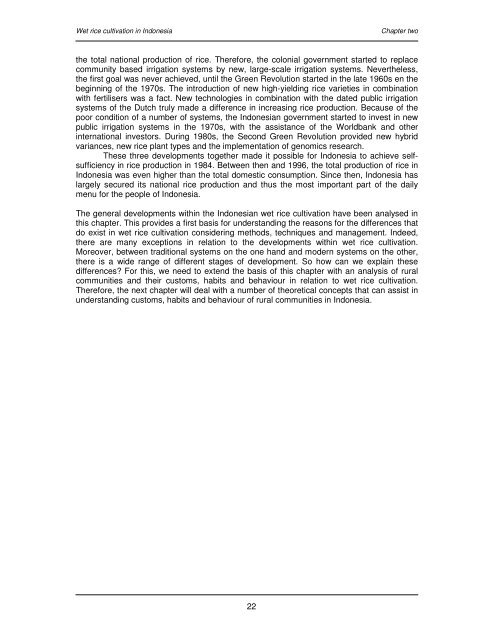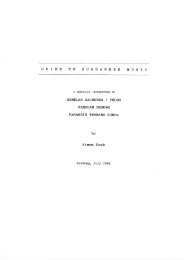Wet rice cultivation in Indonesia - Free EBooks Library
Wet rice cultivation in Indonesia - Free EBooks Library
Wet rice cultivation in Indonesia - Free EBooks Library
You also want an ePaper? Increase the reach of your titles
YUMPU automatically turns print PDFs into web optimized ePapers that Google loves.
<strong>Wet</strong> <strong>rice</strong> <strong>cultivation</strong> <strong>in</strong> <strong>Indonesia</strong> Chapter two<br />
the total national production of <strong>rice</strong>. Therefore, the colonial government started to replace<br />
community based irrigation systems by new, large-scale irrigation systems. Nevertheless,<br />
the first goal was never achieved, until the Green Revolution started <strong>in</strong> the late 1960s en the<br />
beg<strong>in</strong>n<strong>in</strong>g of the 1970s. The <strong>in</strong>troduction of new high-yield<strong>in</strong>g <strong>rice</strong> varieties <strong>in</strong> comb<strong>in</strong>ation<br />
with fertilisers was a fact. New technologies <strong>in</strong> comb<strong>in</strong>ation with the dated public irrigation<br />
systems of the Dutch truly made a difference <strong>in</strong> <strong>in</strong>creas<strong>in</strong>g <strong>rice</strong> production. Because of the<br />
poor condition of a number of systems, the <strong>Indonesia</strong>n government started to <strong>in</strong>vest <strong>in</strong> new<br />
public irrigation systems <strong>in</strong> the 1970s, with the assistance of the Worldbank and other<br />
<strong>in</strong>ternational <strong>in</strong>vestors. Dur<strong>in</strong>g 1980s, the Second Green Revolution provided new hybrid<br />
variances, new <strong>rice</strong> plant types and the implementation of genomics research.<br />
These three developments together made it possible for <strong>Indonesia</strong> to achieve selfsufficiency<br />
<strong>in</strong> <strong>rice</strong> production <strong>in</strong> 1984. Between then and 1996, the total production of <strong>rice</strong> <strong>in</strong><br />
<strong>Indonesia</strong> was even higher than the total domestic consumption. S<strong>in</strong>ce then, <strong>Indonesia</strong> has<br />
largely secured its national <strong>rice</strong> production and thus the most important part of the daily<br />
menu for the people of <strong>Indonesia</strong>.<br />
The general developments with<strong>in</strong> the <strong>Indonesia</strong>n wet <strong>rice</strong> <strong>cultivation</strong> have been analysed <strong>in</strong><br />
this chapter. This provides a first basis for understand<strong>in</strong>g the reasons for the differences that<br />
do exist <strong>in</strong> wet <strong>rice</strong> <strong>cultivation</strong> consider<strong>in</strong>g methods, techniques and management. Indeed,<br />
there are many exceptions <strong>in</strong> relation to the developments with<strong>in</strong> wet <strong>rice</strong> <strong>cultivation</strong>.<br />
Moreover, between traditional systems on the one hand and modern systems on the other,<br />
there is a wide range of different stages of development. So how can we expla<strong>in</strong> these<br />
differences? For this, we need to extend the basis of this chapter with an analysis of rural<br />
communities and their customs, habits and behaviour <strong>in</strong> relation to wet <strong>rice</strong> <strong>cultivation</strong>.<br />
Therefore, the next chapter will deal with a number of theoretical concepts that can assist <strong>in</strong><br />
understand<strong>in</strong>g customs, habits and behaviour of rural communities <strong>in</strong> <strong>Indonesia</strong>.<br />
22








